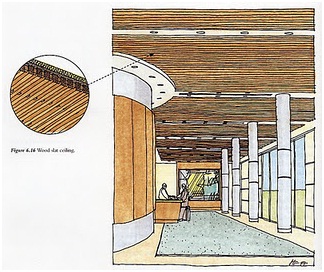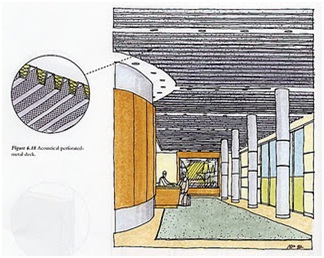





Published on Nov 30, 2023
Sound waves in air result from a physical disturbance of air molecules, such as when a truck drives by a building or when guitar strings are plucked. Sound waves combine and reach a listener via numerous direct and indirect pathways. The listener's inner ear contains organs that vibrate in response to these molecular disturbances, converting the vibrations into changing electrical potentials that are sensed by the brain, allowing hearing to occur.
Acoustical analysis involves not only the sound source but also the listener and everything in between on the path of the sound. The perception of the receiver can be influenced by the treatment of either the path or the source. Some source sound is desirable, for example a lecturer's voice, and some source sound is undesirable, such as the sound output from an idling truck outside a window. Undesirable sound is usually called noise.
Unless it is a pure tone, a sound wave is typically made up of vibrations at different frequencies. Like the impact of a stone in a lake, ripples in the water are created that are analogous to sound in the air. The frequency is basically the number of waves that pass a single point in one second, moving at the speed of sound in air. One wave per second is a frequency of one hertz (Hz). A frequency of 1,000 hertz is a kilohertz
When designing new library buildings or correcting deficiencies of existing library spaces, materials and constructions are selected to control noise and other unwanted sound. The human ear does not perceive all frequencies of sound to the same degree, however, being less sensitive to lower frequency sound pressures than to middle or higher frequency sound pressures. People tend subjectively to measure their perception of the loudness of sounds based more on the SPL of these middle and higher frequency sounds. Design criteria and sound measurement devices are therefore weighted toward these upper frequencies in order to reflect the subjective perception of people in the space.
The term dBA, or A weighted decibel, is often used to describe noise levels in spaces because this type of decibel measurement averaged over the range of frequencies within the range of hearing correlates well with people's subjective perception of the loudness of the noise. Sound level meters, which average the SPL across frequencies, usually have a setting for A-weighting, so that measured noise levels correlate to the human perception of the differences in noise level.
The NC Rating is an acoustic design criterion for the target level of background noise in a room. This criterion is based on the fact that human hearing is less sensitive to lower frequencies than to higher frequencies, so that a specific criterion for the SPL of background noise in a space varies with the frequency of the noise spectrum. Figure 2.3 shows the Noise Criteria (NC) used in acoustic design. The loudest frequency region of the background noise sets the NC-curve that applies to the space
To meet the criteria of NC-25, for example, the measured loudness of all frequencies must fall at or below the NC-25 curve. A new building program should list the acoustic criteria for each space. These criteria will usually include an NC Rating requirement, which depends on the appropriate level of background noise to the tasks and activities in the space
Room acoustics pertains to the physical characteristics of a space for the hearing of direct and reflected sound. In libraries, the principal issue for room acoustics is speech intelligibility and control of background noise levels. Rooms with a high level of reflected sound may have poor room acoustics depending on the use of the room since the persistence of the sound creates unwanted background noise and interferes with the ability to understand speech. Such rooms are said to have a high reverberation time, the time required for the sound to be absorbed gradually and reduced below hearing levels.
Therefore, design principles for room acoustics in library spaces typically focus on the locations and extent of sound absorbing material, to reduce reverberation and the interference with speech, as well as the shape of rooms to achieve acceptable acoustic characteristics in meeting and presentation rooms.
Multi-purpose rooms require special room acoustics design since these spaces often must accommodate speech and musical activities at different times. For speech activities, the reverberation time should be low enough to allow syllables of parts of speech to be readily understood. Longer reverberation time is preferred for musical functions, since the musical sounds need to reverberate properly. A room having reverberation time of more than 1.5 seconds may be acceptable for music listening but would probably create interference with speech intelligibility. A room having a reverberation time of less than 1 second would probably be judged acceptable for speech intelligibility but musicians may complain about the room being too “dead”. The different methods of noise and sound control in buildings are
All materials have some sound-absorbing properties. Sound energy that is not absorbed must be reflected or transmitted. A material’s sound-absorbing property is typically described as a sound absorption coefficient at a particular frequency range. Sound absorbing materials used in buildings are rated using the Noise Reduction Coefficient (NRC), which is basically a type of average of sound absorption coefficients from 250 Hz to 2 kHz, the primary speech frequency range. The NRC theoretically can range from perfectly absorptive (NRC = 1.0) to perfectly reflective (NRC = 0.0).
Adding sound-absorbing materials to a space usually becomes an interior design issue in the library. Many options are possible to provide sound absorption on walls and ceilings, which are attractive and maintainable. Absorptive materials are often covered with acoustically transparent surfaces such as fabric, perforated metal and spaced wood slats. These surfaces allow the sound energy to pass through and be absorbed by the material located behind. Figure 3.1 shows the example of a wood slat panel treatment that effectively screens the acoustic blanket and creates a handsome ceiling in a public area.
Perforated metal panels, as shown in Figure 3.2, are commonly used to create a certain finish appearance. For best results, the material should be as thin as possible, with the smallest hole diameter and the greatest open area (the greatest number of holes).
Some absorptive materials are attractively designed to be exposed to view, such as normal suspended ceiling tiles. Generally, thicker porous materials provide better sound absorption. 5/8-inch thick ceiling tiles have an NRC of 0.50 when mounted in a lay in grid ceiling. A 1-inch thick glass fiber ceiling tile can have an NRC rating of 0.80 or greater. Figure 3.3 illustrates the appearance of a suspended acoustical tile ceiling.
Another approach to adding acoustic absorption to the space is to suspend acoustic baffles as shown in Figure 3.4


Open-cell foam panels are effective sound absorbers because they have increased surface area due to the contoured surface of the foam. Figure 3.5 illustrates an application near an open copy machine area. Figure 3.6 shows another type of fabric-covered absorptive material.
Everyone has experienced unwanted sound intrusion – a television in the next room, a loud neighbour walking on the floor above, or a jet flying over. Measures are often required to reduce intrusive noise. One of the most essential techniques in acoustics is reducing the transmission of sound through solid barriers in buildings. This form of sound reduction is referred to as Sound Insulation.
The reduction of sound energy from one building area to another by absorbing it or reflecting it with an intervening solid panel of material is called sound transmission loss (TL). Typically, building materials attenuate more high frequency noise than low frequency noise. The higher the mass or weight of a wall, the more force is required to make it vibrate. For this reason a massive wall has higher TL at all frequencies than a lighter panel.
Another way to increase the transmission loss of a panel or construction, such as a wall, is by increasing its thickness and isolating one side of the construction from the other. This is commonly done by using two panels separated by an air cavity, and is known as a dual panel partition. Doubling the air space width increases the TL by about 5 dB. Usually, the dual panel approach is more effective and lower cost than increasing wall mass.
These sound reducing partitions are needed between spaces with different acoustic requirements or spaces that require acoustic privacy. They are also necessary in some cases as part of the exterior building envelope, if environmental noise at a site is a particular concern. Walls, floors and ceilings enclosing spaces where unwanted noise is generated, such as mechanical rooms, normally require a high standard of sound reduction.
A standard partition used to separate rooms in a building is typically a single stud wall and one layer of gypsum board on each side, and it has an STC rating of 35. The acoustic performance of the standard wall can be improved by using light gauge (25 gauge) metal studs instead of wood studs. There are some conditions in a library where more sound isolation will be required, which can be accomplished by adding insulation within the wall cavity, providing a second layer of gypsum board on each side of the partition, or possibly using staggered stud construction. These program areas include conference rooms and offices requiring confidential speech privacy, where STC ratings in the range of STC 45-50 are recommended. To control noise transfer from rooms having amplified sound systems such as meeting rooms into other library spaces, the surrounding walls should have a minimum rating of STC 55-60
It is important to note in general that the high STC rating of any wall construction can be compromised in a number of ways. Care should be taken during actual construction of these sound-rated partitions to ensure that common construction errors do not occur. These compromising circumstances could be the following:
1. Air or sound leaks through cracks. A small air gap can completely compromise the effectiveness of the wall construction. Long cracks, such as those that normally occur at the base and top of a wall are especially detrimental. For this reason, flexible acoustic caulking should be used at the perimeter of a sound partition to seal all edge cracks.
2. Air or sound leaks through normal openings in the wall. Electrical and data outlet boxes or other penetrations of the wall for plumbing or sprinkler piping must also be carefully sealed with flexible acoustic caulking. A common error is to place electrical outlet boxes for two rooms back-to-back in the intervening sound partition. These boxes should be located in different stud spaces to prevent sound transfer between the rooms.
3. Structural connections between double stud partitions. The wood studs in each partition frame of a double stud wall must not be structurally coupled to the other frame in any way. No plumbing or electrical lines should be located in the open space of the air gap between the two partition frames.
4. It is important to seal both faces of a concrete masonry wall with paint or plaster in order to control possible sound leaks.
| Are you interested in this topic.Then mail to us immediately to get the full report.
email :- contactv2@gmail.com |